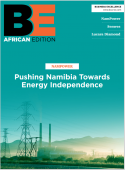Opportunity in the pipelineExpertise that Robert B. Somerville developed working on pipeline for the oil and gas market has applications in many other areas as well, Linda Seid Frembes learns. The increasing focus on energy consumption and energy independence has also put a spotlight on infrastructure projects. Investment in the worldÔÇÖs aging infrastructure has provided new opportunities for companies like Robert B. Somerville (RBS), a pipeline construction and installation company based in King City, Ontario. Founded in 1951, the companyÔÇÖs expertise began in the oil and gas pipeline utilities market but has since expanded to renewable and alternative energy projects.Today, the company services oil and gas pipelines, wind farm utilities, district energy, mainline and distribution pipeline construction, pipeline fabrication, maintenance and testing, installation of underground distribution systems for electricity, telephone, cable television and fiber optics, and facilities. ÔÇ£We are the contractor that builds the infrastructure for pipelines and compressor stations,ÔÇØ explains Abe Dyck, contract manager for RBS, who has worked at the company for 12 years, beginning as a project manager. ÔÇ£We are not involved much in the design of the projects, although we can assist with elements like feasibility studies.ÔÇØThe companyÔÇÖs strength lies in large-diameter pipelines measuring 12 to 42 inches and running in excess of 120 kilometers (75 miles) long. ÔÇ£One of the technologies that is drastically changing our business is horizontal directional drilling,ÔÇØ says Dyck. ÔÇ£Instead of digging a large trench for the entire length of pipe, horizontal directional drilling allows us to drill down at an angle and then straighten it out to clear a horizontal path. It doesnÔÇÖt disturb the surface above, which is important in urban settings like city streets and on highway projects.ÔÇØAt one point, Dyck notes that RBS had the largest horizontal directional drilling fleet. While other companies┬áhave used the technology for small-diameter projects, RBS remains the leader in horizontal drilling for large-diameter pipes. Dyck adds, ÔÇ£The technology existed in the United States, but we introduced it to utilities in Canada. We got them to accept and adopt the technology; we were one of the first contractors to advocate for it.ÔÇØThat forward-thinking approach has cemented relationships with some of CanadaÔÇÖs leading pipeline and utilities companies, such as Enbridge, TransCanada Pipelines Ltd., Westcoast Energy, Union Gas, TransNorthern Pipelines Inc., Toronto Hydro, 360networks Inc., Hydro One, City of Toronto, Bell Canada, Greater Toronto Airports Authority, Imperial Oil, Maritimes & Northeast Pipeline and Sarnia Products Pipeline.RBS presently holds four annual ÔÇ£self directionÔÇØ contracts with Enbridge. These managed contracts mean that when a homeowner decides to switch to natural gas heating, the work order is received and processed using Enbridge systems, but RBS crews handle the installation and reporting. According to Dyck, the partnership extends to all pipeline work in Ontario. ÔÇ£This dovetails well with our utility work, since builders want a multi-utility [joint] trench that houses utility, cable, and fiber optic lines,ÔÇØ he says.The focus is primarily on underground workÔÇöthe excavation, drilling, fabricating and installation of pipe. Dyck notes that RBS is a unionized company but is not signatory to electricians, so cable work is handled by other parties.┬á The company expanded into utility work over the past 15 years, during a slowdown in the oil and gas sector that occurred while there was a convergence of utility companies. ÔÇ£In early 2000 there was a slump in large-diameter oil and gas work, but the utilities work helped us through it. Today weÔÇÖre partnering with international firms due to ever-larger projects. Many projects are over $100 million, especially west in Alberta. Joint ventures mitigate risk for shareholders,ÔÇØ he adds. RBSÔÇÖs joint venture is with Techinc of Argentina and is called Techinc/Somerville.To keep its workforce growing, RBS has developed outreach programs to get younger people involved in the trade. ÔÇ£Our average workforce age is 45 years. A huge volume of work is in the West, so that means there is less of a labor pool in Ontario,ÔÇØ says Dyck. ÔÇ£The key is to introduce trades directly to the children of our employees and also to reach out to students at the high school level. WeÔÇÖve developed a scholarship program for any student interested in civil, electrical or mechanical engineering or in joining a trade.ÔÇØThe typical timeline for a scholarship student is to work for the company as a co-op, then return as a summer intern and later join the company as an employee. Dyck adds, ÔÇ£WeÔÇÖre also using union members to visit schools and show students that trades are just as good, if not better, for a career as doctors or lawyers.ÔÇØJob safety is also a priority, one that became a focal point three years ago. ÔÇ£We were above the industry average for worker compensation ratings, so we were paying higher surcharges,ÔÇØ Dyck says. ÔÇ£In response, we hired a safety specialist who developed a training program that begins at employee orientation.ÔÇØAccording to Dyck, job security is created by project continuity. ÔÇ£We fill the spaces in between multi-year contracts with shorter-term projects. This type of scheduling makes it easier to do manpower loading to achieve efficiency,ÔÇØ he says. ÔÇ£ItÔÇÖs not done with software but more human involvement and measured from a macro level.ÔÇØMoving forward, the prospects of renewable energy projects like solar and wind power are strong. Using the expertise gained in oil and gas and in the utilities market, RBS is well positioned to provide the resources required for renewable projects. The company is currently in talks with several major projects, including pipeline for a 100-plus-acre wind farm. The company is also focusing its expertise on district energy, the use of hot or chilled water to heat and cool buildings that is popular in Sweden and Finland. RBS is involved with the Regent Park project for Toronto Community Housing that will use heated waterÔÇöa byproduct of natural gas productionÔÇöto heat and cool their structures. RBS is also working with the Ontario Power Authority on hydroelectric, which Dyck sees as an opportunity for high-voltage transmission pipelines. ÔÇ£Our expertise in pipeline work is transferable to many markets, including those at the forefront, such as renewable energy,ÔÇØ says Dyck. ÔÇ£Water and sewer infrastructure has similar characteristics to oil and gas pipeline, so that is yet another market that presents additional opportunities.ÔÇØ┬á









